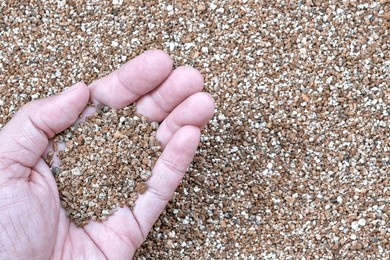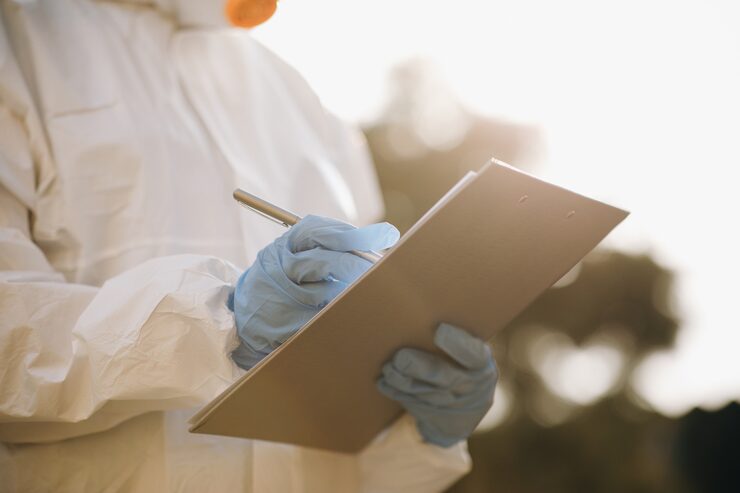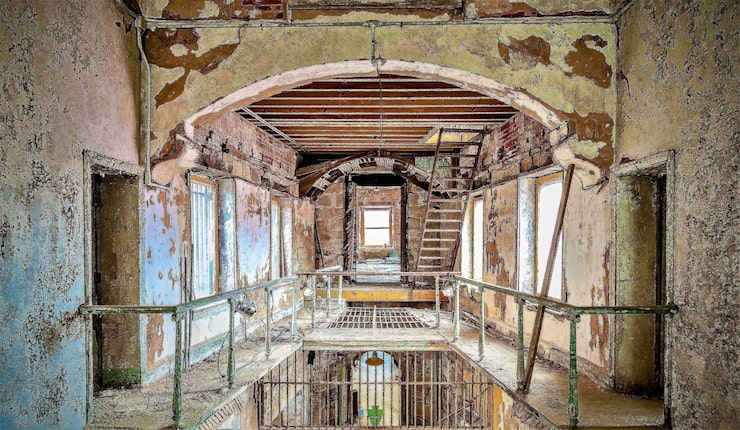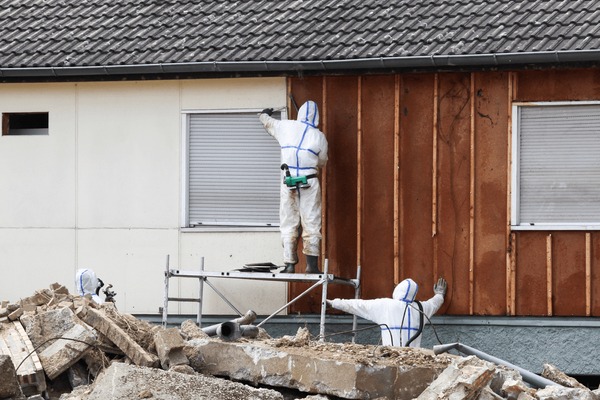No matter the size of the project or the industry you operate in, you need to be certain your working environment is as safe as possible. While there are many layers to achieving this, one of the most important components is asbestos testing.
Asbestos was used throughout Australia up until the mid-1980s, when research began to show that the material was associated with a variety of serious health conditions. According to Healthdirect Australia, exposure to asbestos may increase the risk of asbestosis, mesothelioma, lung cancer, pleural disease and other types of cancer.
Worryingly, other commonly building materials have been found to contain asbestos. Vermiculite, a durable silicate material, was sold for over 50 years in Australia before research found it had been contaminated with traces of asbestos.
What exactly is vermiculite? Is it dangerous? And how can you tell if it’s present in your building? We’ve compiled all the information you’ll need to answer these questions and more.
Understanding Vermiculite
Vermiculite is a naturally occurring silicate material that expands significantly when exposed to heat. In its expanded state, vermiculite exhibits a range of properties that make it well suited for industrial use. In addition to being an excellent insulator, it’s also non-combustible, absorbent, compressible, odourless and inert – valuable attributes that have seen it widely used across many industries.
Despite its widespread use, there are a number of health risks associated with vermiculite. While pure vermiculite is relatively safe, there are a number of cases where vermiculite-based products were contaminated with asbestos during the extraction or distribution process and sold to companies and the public. This means that many people could be at risk if they carry out construction or demolition work on a property containing tainted vermiculite.
Unfortunately, this is a very real concern here in Australia. Asbestos-containing vermiculite was sold here for decades, and experts estimate that thousands of homes across the country could contain contaminated vermiculite to this day. Of course, it’s not just residential homes that are at risk. For example, in 1988, more than 800 cubic metres of vermiculite was removed from the roof of the Canberra Centre, highlighting just how widespread the issue could potentially be.
Why Vermiculite Can Be Dangerous
Vermiculite is a natural mineral that is not inherently dangerous. The main health risk comes from asbestos contamination. For decades, a large portion of the world’s vermiculite was sourced from a mine in Libby, Montana. However, it also naturally had accumulated asbestos. This led to heavy contamination of vermiculite with asbestos fibers.
Here is why asbestos contamination makes vermiculite dangerous.
Asbestos Pollution
Asbestos is a group of naturally occurring minerals. But it is composed of thin needle-like fibers. So, asbestos can severely damage your lungs. The chances of lung having cancer is higher for breathing asbestos than smoking. So, asbestos pollution is a concerning issue. Yet, the most common types of vermiculite insulation are highly likely to contain asbestos.
Airborne Fibers
The danger from asbestos comes from inhaling the fibers when they become airborne. In general, undisturbed vermiculite poses a low risk. However, any activity that moves, breaks, or disturbs it can lead to the microscopic fibers being released into the air. So, tasks like renovation, demolition, and even the simpler ones like moving items with vermiculite insulation can be hazardous.
Common dust masks fail to provide adequate protection against asbestos fibers, as they are thousands of times thinner than human hair.
Health Risks
Asbestos fibers can become lodged in the lungs once inhaled. They can lead to serious and often fatal illnesses. The body struggles to break down the fibers. So, over time, your lung tissues will get inflamed and scarred. These are the main health risks associated with asbestos exposure.
- Asbestosis: This is a chronic non-cancerous lung disease resulting from the scarring of lung tissue. It can cause respiratory difficulties and chronic dry cough.
- Mesothelioma: This is a rare and aggressive form of cancer that affects the lining of the lungs, heart, or abdomen. This disease is typically caused only due to asbestos exposure.
- Lung Cancer: Asbestos exposure can significantly increase the risk of lung cancer. This risk from asbestos exposure is even greater for smokers.
Long Latency Period
One of the stealthiest aspects of asbestos-related diseases is their long latency period. You may not see any symptoms for 10 to 50 years after the initial exposure. This means that if you were exposed to asbestos-contaminated vermiculite during a home renovation decades ago, there may not be any sign of illness until later in your life.
The long delay makes it difficult to connect the disease to the original exposure. So, you may be diagnosed late while there are only a few care options.
How to Minimise Your Risk of Vermiculite
Here are the things to remember to minimise the risks of vermiculite.
Do Not Disturb
Not disturbing vermiculite at all is the safest way to handle the material. Work with an assumption that the vermiculite insulation is contaminated with asbestos. Disturbing it will make the asbestos fibres airborne.
Seal and Contain
Inspect your ceilings for holes or cracks, and seal them. This is necessary from presenting insulation from getting into your living space. Use plastic sheeting for sealing the affected area. Clean up materials using plastic bags.
Professional Remediation
Hire a qualified asbestos remediation professional with proper license if you need to handle or remediate vermiculite. The professionals may first collect and test samples to confirm the presence of asbestos.
Wearing Respirators
Wear a half-face respirator if you have to enter an attic contaminated with asbestos. Common dust masks won’t be able to protect you. So, go for N-100, R-100, or P-100 filters. N-95 masks are not adequate. Also, wear disposable clothes and gears, including gloves and hood. Wear protective eyeglasses as well.
Cautious Gardening
Vermiculite may be present in potting soil. So, you must dampen the solid with water to reduce the risk. Try to keep the soil moist when handling it. Get your garden’s soil taste for contaminants. Avoid disturbing areas where contaminated soil is detected.
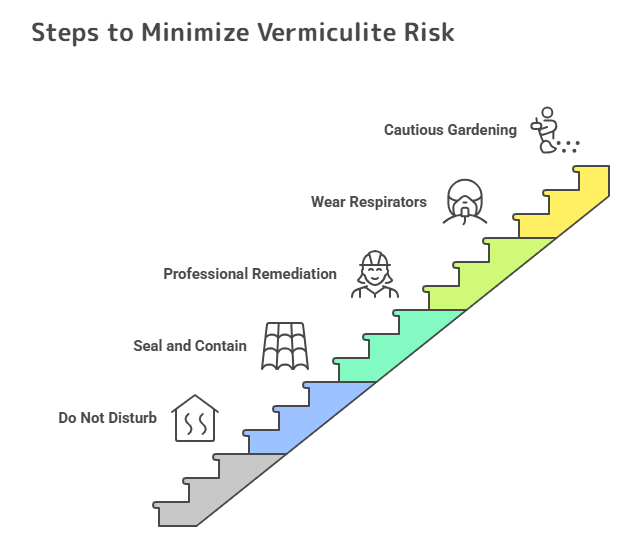
How Do We Use Vermiculite in Australia?
As noted, the unique characteristics of vermiculite make it very appealing for use across a variety of sectors, including:
Construction
We touched on it before but it’s worth repeating: vermiculite is an excellent insulator. This makes it the perfect addition to construction materials such as concrete, where durability and resilience are obviously highly valued. Vermiculite is more or less impervious to fire and is very light in weight (compared to conventional concrete, at least), allowing builders to get more creative with their designs. While it can be used in many elements of a home’s design, vermiculite concrete can most commonly be found in precast concrete products, fireplace insulation and the roof and floor screeds.
Its heat retaining properties mean that vermiculite is widely utilised in building insulation. It’s incredibly easy to install in spaces of all shapes and sizes, while the material does an amazing job of minimising heat loss and regulating the temperature of indoor areas. Insulation material is the most common source of vermiculite asbestos. If you suspect your property may contain vermiculite asbestos, be sure to enlist the services of a professional and carry out a comprehensive asbestos test.
Vermiculite is also used in some types of plaster. It offers some notable advantages over traditional plaster, including better coverage, excellent adhesion and superior resistance to heat and fire.
Horticulture
It goes without saying that horticulture plays an important role in the local economy. In fact, Australian horticulture has an annual gross value of almost $9 billion, according to figures collated by the Department of Agriculture and Water Resources.
The country’s ability to produce food depends on the quality of our soil, and this is where vermiculite comes into play. Due to its expanding properties, the mineral allows nutrients, water and air to penetrate the soil, allowing plants and crops to grow much more efficiently. Vermiculite’s natural ability to absorb moisture also helps growing substrates retain water, which is very useful in the more arid parts of Australia where hydration efficiency is critical. As further evidence of its versatility, vermiculite is often used in fertilisers and pesticides, and even serves a purpose for encapsulating seeds.
Fireproofing Products
Thanks – at least in part – to its incredibly high melting point of 1350 degrees Celsius, vermiculite is commonly used in fireproofing and fire protection products. These products range in function from sprayable premixed coatings to standard fire resistant boards and everything in between. In the petrochemical industry, where heat and fire are perhaps the two greatest risks to worker safety and operational efficiency, vermiculite-based goods are ubiquitous.
Pool Liners and Packing Material
Vermiculite is utilised in some niches that have very particular requirements. Exfoliated vermiculite is incorporated into many types of swimming pool liners, as the mineral offers a steady base while simultaneously insulating the bottom of the pool against the harsh, cold terrain. The porous nature of vermiculite reduces the risk of structural damage if changes in the water table level affect the swimming pool.
Distribution centres have also benefited from the use of vermiculite. Unlike other packing materials, the exfoliated mineral is pourable, meaning it can effortlessly provide protection for objects of any shape and protect them from any damage that may occur during the transportation process.
The Importance of Vermiculite Asbestos Testing
Despite the many uses and benefits of vermiculite, exposure to the mineral does carry some potential health risks due to its association with asbestos. With this in mind, it’s vital that you take the time to perform an asbestos analysis to ensure the vermiculite on your work site is not contaminated with the hazardous substance.
With extensive experience across all aspects of environmental safety testing, SERS is your number one choice when it comes to asbestos testing in Australia. Get in touch with the team today to find out more.
Frequently Asked Questions
How Do I Understand if My Vermiculite Insulation is Asbestos-contaminated?
Visual inspection will not help you spot asbestos-contamination in vermiculite. A sample assessment in the lab is necessary. So, you can get your attic or insulation tested in a certified laboratory to confirm contamination. But the safety rule is to believe that every vermiculite is tainted.
What if I Doubt That My Vermiculite Insulation is Asbestos-contaminated?
Don’t disturb or handle it yourself if you are not a trained professional. You don’t want to be exposed to fibres that can cause diseases decades later. It is best that professionals perform the necessary tests, confirm the presence of asbestos, and take the right remedial actions.
I Think I Was Heavily Exposed to Asbestos-contaminated Vermiculite in the Past – Am I at Risk?
Yes, you might be at risk. But the exact risk will depend on the level, frequency, and duration of past exposure. Asbestos-related illnesses can show symptoms decades after exposure. So, get yourself medically assessed if you doubt significant exposure.
Is It Okay to Encapsulate Asbestos-contaminated Vermiculite Instead of Removing It?
Encapsulation is potentially an option to handle asbestos-contaminated vermiculite. But this is only safe if the condition of the material is good. You need to make sure that the material will not be disturbed during encapsulation. Also, encapsulation is not a permanent remedy and is still risky. Adding more insulation will only make future remediation costly.


